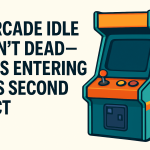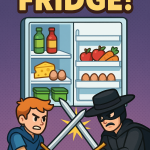Why This Genre Still Holds the Keys to Scalable Hybrid-Casual Success
Idle Arcade games once stormed the hyper-casual charts: tap to collect, automate to scale, repeat. But what started as a gold rush of low-CPI, high-churn prototypes has fractured under pressure.
Now? The genre sits at a critical junction. Saturation and rising CPIs have broken the old model. But for developers who know how to evolve the loop—and more importantly, the systems behind it—Idle Arcade remains one of the most resilient bridges into hybrid-casual territory.
Let’s break down what’s still working, what isn’t, and where smart design is quietly winning.
📉 From Chart-Toppers to Churn Machines
Arcade Idle games from the top 20 (WW) are showing D1 Retention between 48% and 52%. Day 7 varies from 7% to 13%.
Sensor Tower & Homa Games, 2022
Back when rewarded videos were cheap and novelty was enough, the formula worked:
- Easy to learn, impossible to master (or so the ad said)
- High volume, low engagement depth
- Monetized almost entirely through brute-force ad frequency
And it worked—until it didn’t.
As CPIs rose and players got savvier, pure idle arcade loops began to underperform. Publishers shifted priorities: from instant marketability to long-term monetization, from first impressions to retention curves. Idle Arcade had to evolve—or die.
🧪 The New Formula: Hybrid-Casual Idle Arcade
The big winners in the space — such as Alien Invasion: RPG Idle, Wasteland Life Survival, My Perfect Hotel— didn’t reinvent tapping. They just layered smarter systems around it.
Here’s the playbook:
1. Idle for Flow, Not Filler
Idle still works—but not as filler. As flow.
The best games don’t just automate—they compound. They stack progress in ways that feel earned, visible, and emotionally satisfying.
What matters is:
- Resource collection that feels dynamic
- Upgrades that meaningfully change visuals
- Automation as both reward and aspiration
Example: Wasteland Life: Survival by SayGames demonstrates this shift perfectly.
At its core, it’s an idle collector—scavenging, building, automating. But what elevates it is how the player’s base evolves across sessions: new zones unlock, survivors appear, structures improve. Every action—however small—feeds into a feeling of rebuilding civilization from scratch. That emotional arc is retention fuel.

2. Monetization Is Environmental, Not Just UI
The best idle hybrids no longer shove monetization into the UI—they embed it into the world.
✅ A trader at your camp offering time-limited deals
✅ Workers that automate scavenging for one hour—unless upgraded or purchased
✅ Ruined zones that require RV or soft currency to rebuild faster
You’re not selling coins. You’re selling presence, progress, and privilege in a post-apocalyptic world the player is actively restoring.
3. The Retention Layer Is Mission-Critical
This part can’t be skipped. CPIs are never going back to $0.20—and that’s fine, as long as your LTV holds up.
The games that endure are built around rituals, milestones, and long arcs. Players don’t return because the tap is fun—they return because they have unfinished business (Zeigarnkik effect) and rewards waiting for them to be collected.
Here’s what that looks like in Wasteland Life: Survival:
- Daily rituals: Gather supplies, repair barricades, assign tasks
- Calendar events: Radiation storms, supply drops, time-limited scavenging missions
- Deferred goals: Unlock the bunker on Day 3, recruit ally by Day 7, open the water filtration system after 5 sessions
Retention isn’t just about loops—it’s about long arcs that players opt into. Design for Day 14+, not Day 1, because that’s where your monetization truly begins.
And it’s more important than ever, especially as we’re seeing hybrid-casual hits like Block Jam 3D and Mob Control migrate fully into the casual tier.
4. Creative-Ready Systems Win the UA War
This part hurts—because I’m a game dev first. But here’s the reality: if your game doesn’t look incredible in a 30-second ad, it may never get the shot it deserves.
As much as we love building for depth, marketability still pays the bills. Which means we need to design for both hands: gameplay and ad creative.
That means:
- Visual transformation (dirty to clean, empty to full, basic to upgraded)
- Clear feedback (explosions, multipliers, “you did it!” animations)
- User agency (“I made this better”)
CPI is still your gatekeeper. Make your core loop perform in video.
5. Your Vertical Slice Must Signal LTV
Undeniable fact, your prototype must signal layering, both for monetization and playability. When publishers evaluate Idle Arcade prototypes now, they’re asking:
“Can this scale into a hybrid-casual product with real monetization?”
To pass that test, your vertical slice should show:
- A monetization funnel (RV, IAP, and optional subs all scaffolded)
- Light meta (upgrades, soft currency, NPC automation)
- Signs of LiveOps readiness (offer slots, dynamic content, event scaffolding)
🎯 What Makes an Idle Arcade Prototype Stand Out Today
You’re not building a moment. You’re building a system. The best Idle Arcade games aren’t just fun—they hold players, invite return, and set up long-term monetization without feeling exploitative.
Here’s your internal checklist before you put a prototype in front of players:
| Element | Why It Matters |
|---|---|
| ⚙️ Core idle/tap loop | Should deliver immediate satisfaction and clear progression—players need to feel the loop compounding fast. |
| 🛍 In-world monetization nodes | Design monetization inside the game world (VIP stations, limited-time helpers) to feel natural and rewarding. |
| 🧱 Expansion and unlockables | Unlocking new areas, systems, or content fuels curiosity and supports retention beyond early sessions. |
| 🔁 Rituals & milestones | Daily loops and long-term goals (e.g. rebuild, automate, evolve) encourage sustained engagement over weeks. |
| 💰 Early monetization hooks | Introduce moments where players want to spend (or watch ads) based on value—not frustration. |
| 🧪 Instrumentation & feedback | Even in early builds, track what matters: session length, ad opt-in rate, soft currency sinks. Let data guide iteration. |
Final Thought
Idle Arcade isn’t dead. But it’s not just hypercasual anymore, either.
This genre has become a strategic space—one where the right blend of feedback, monetization, and progression can unlock serious upside. But only if we design for more than Day 1.
Build for long arcs.
Design for clarity under pressure.
Prototype not to impress—but to prove.
If this sparked any ideas—or raised questions—feel free to reach out.
Always happy to talk more about Idle Arcade, hybrid systems, or anything in between.


